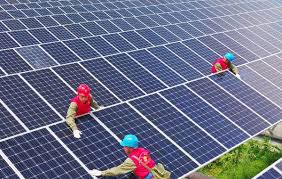
ISLAMABAD, Nov. 5 (INP): Pakistan is undergoing a booming energy shift resulting in solar energy adoption among all orders of society.
Pakistan imported around 15 GW (worth about USD 2.1 billion) of solar panels from China over the past fiscal year, newest industry research highlights.
Contributing to this transition is the increased electricity tariffs- actuating high-energy-consuming households and industries to switch to solar solutions-which is not only cheap but also efficient.
In the past year this has resulted in a 10.4% drop in grid electricity demand, thus decentralized energy generation has become a must for this South Asian country long plagued by power shortages.
Global and local analysts attribute Pakistan’s rapid shift toward solar energy to a consumer-driven “solar boom”, citing rising electricity costs, falling technology prices and strong import trends as the main reasons.
Not long ago, global photovoltaic provider giant LONGi held a press conference in Karachi to launch its new product Hi-MO X10, with a battery efficiency reached 26.6%.
Pakistan is ushering in a new energy transformation in full swing. In 2024, our shipments in Pakistan reached 3GW, and the total shipments since entering local market have reached 7GW,” a person in charge of LONGi Pakistan pointed out.
Pakistan’s electricity prices were adjusted 14 times between July 2023 and August 2024, causing local consumers to spend more than Rs 455 billion on electricity bills. In March 2024, the highest increase was Rs 7.06 per unit.
According to Bloomberg, some Pakistanis’ electricity bills are even higher than their monthly house rent of USD 100-700. In contrast, installing solar PV can reduce the bill by at least 60% to 70%.
“In the next five years, K-Electricity plans to add about 1,200MW of renewable energy projects and gradually phase out expensive energy sources such as liquefied natural gas and fuel oil,” Shahab Qader Khan, Chief Strategy Officer of K-Electricity, Karachi’s main power supply company, said in an interview.
“If Pakistan continue to receive affordable Chinese solar systems, installed solar capacity is expected to grow from 1.41 gigawatts in 2024 to 9.53 gigawatts by 2029, at a compound annual growth rate (CAGR) of 46.55%,” a WAPDA official noted.
“Obviously, the current general price of PV products may still be just at or just below the price range of local traditional energy, thus its attractiveness needs to be improved.
As our products continue to reduce costs and increase efficiency, their attractiveness in Pakistan, South Asia and even the world will further increase,” Liu Yiyang, Deputy Secretary General of China Photovoltaic Industry Association (CPIA), told Gwadar Pro.
“In addition to some Chinese companies starting to build large-scale centralized projects in Pakistan, more local people are also turning to household photovoltaics due to rising electricity prices for traditional energy.
The combination of these two will further boost the vigorous development of local PV demand,” Liu added.
“The global photovoltaic industry is developing in full swing. China-Pakistan cooperation in related industries can make due contributions to the global response to climate change,” Ali Majid, Pakistan General Manager of LONGi, emphasized,
“By providing high-quality solar panels and promoting sustainable energy solutions, we are aiding the country in achieving its renewable energy goals.”
A solar energy revolution is taking place across Pakistan. Since July, Sindh Province has announced that it will promote 200,000 PV home systems across the province, and plans to build several large-scale photovoltaic projects, each with a capacity of 305 MW.
Balochistan’s PV conversion plan is proceeding in an orderly manner, which will help agricultural water wells switch from fossil fuel-driven to PV power generation, thereby reducing fuel costs and improving energy efficiency.
Since August, Punjab Province has also introduced a policy of free supply of PV modules.
For citizens with electricity consumption of no more than 200 units, the policy allows them to obtain photovoltaic modules for free from August 14, while citizens with electricity consumption of more than 200 but no more than 500 units will have to pay 10% of the cost, and the remaining 90% of the cost will be borne by the government.
Under this policy, it is expected that the electricity cost burden of low-income households will be reduced by about 40%.
INP/javed































































































